LFIR2Pose: Pose Estimation from an Extremely Low-Resolution FIR Image Sequence
Saki Iwata,
Yasutomo Kawanishi,
Daisuke Deguchi,
Ichiro Ide,
Hiroshi Murase,
Tomoyoshi Aizawa

Auto-TLDR; LFIR2Pose: Human Pose Estimation from a Low-Resolution Far-InfraRed Image Sequence
Similar papers
RefiNet: 3D Human Pose Refinement with Depth Maps
Andrea D'Eusanio, Stefano Pini, Guido Borghi, Roberto Vezzani, Rita Cucchiara

Auto-TLDR; RefiNet: A Multi-stage Framework for 3D Human Pose Estimation
Exploring Severe Occlusion: Multi-Person 3D Pose Estimation with Gated Convolution
Renshu Gu, Gaoang Wang, Jenq-Neng Hwang

Auto-TLDR; 3D Human Pose Estimation for Multi-Human Videos with Occlusion
What and How? Jointly Forecasting Human Action and Pose
Yanjun Zhu, Yanxia Zhang, Qiong Liu, Andreas Girgensohn

Auto-TLDR; Forecasting Human Actions and Motion Trajectories with Joint Action Classification and Pose Regression
Abstract Slides Poster Similar
StrongPose: Bottom-up and Strong Keypoint Heat Map Based Pose Estimation

Auto-TLDR; StrongPose: A bottom-up box-free approach for human pose estimation and action recognition
Abstract Slides Poster Similar
A Multi-Task Neural Network for Action Recognition with 3D Key-Points
Rongxiao Tang, Wang Luyang, Zhenhua Guo

Auto-TLDR; Multi-task Neural Network for Action Recognition and 3D Human Pose Estimation
Abstract Slides Poster Similar
Rotational Adjoint Methods for Learning-Free 3D Human Pose Estimation from IMU Data
Caterina Emilia Agelide Buizza, Yiannis Demiris

Auto-TLDR; Learning-free 3D Human Pose Estimation from Inertial Measurement Unit Data
A Grid-Based Representation for Human Action Recognition
Soufiane Lamghari, Guillaume-Alexandre Bilodeau, Nicolas Saunier

Auto-TLDR; GRAR: Grid-based Representation for Action Recognition in Videos
Abstract Slides Poster Similar
Video Analytics Gait Trend Measurement for Fall Prevention and Health Monitoring
Lawrence O'Gorman, Xinyi Liu, Md Imran Sarker, Mariofanna Milanova

Auto-TLDR; Towards Health Monitoring of Gait with Deep Learning
Abstract Slides Poster Similar
Better Prior Knowledge Improves Human-Pose-Based Extrinsic Camera Calibration
Olivier Moliner, Sangxia Huang, Kalle Åström

Auto-TLDR; Improving Human-pose-based Extrinsic Calibration for Multi-Camera Systems
Abstract Slides Poster Similar
Pose-Based Body Language Recognition for Emotion and Psychiatric Symptom Interpretation
Zhengyuan Yang, Amanda Kay, Yuncheng Li, Wendi Cross, Jiebo Luo

Auto-TLDR; Body Language Based Emotion Recognition for Psychiatric Symptoms Prediction
Abstract Slides Poster Similar
Orthographic Projection Linear Regression for Single Image 3D Human Pose Estimation
Yahui Zhang, Shaodi You, Theo Gevers

Auto-TLDR; A Deep Neural Network for 3D Human Pose Estimation from a Single 2D Image in the Wild
Abstract Slides Poster Similar
Space-Time Domain Tensor Neural Networks: An Application on Human Pose Classification
Konstantinos Makantasis, Athanasios Voulodimos, Anastasios Doulamis, Nikolaos Doulamis, Nikolaos Bakalos

Auto-TLDR; Tensor-Based Neural Network for Spatiotemporal Pose Classifiaction using Three-Dimensional Skeleton Data
Abstract Slides Poster Similar
Inner Eye Canthus Localization for Human Body Temperature Screening
Claudio Ferrari, Lorenzo Berlincioni, Marco Bertini, Alberto Del Bimbo

Auto-TLDR; Automatic Localization of the Inner Eye Canthus in Thermal Face Images using 3D Morphable Face Model
Abstract Slides Poster Similar
Boundary Guided Image Translation for Pose Estimation from Ultra-Low Resolution Thermal Sensor
Kohei Kurihara, Tianren Wang, Teng Zhang, Brian Carrington Lovell

Auto-TLDR; Pose Estimation on Low-Resolution Thermal Images Using Image-to-Image Translation Architecture
Abstract Slides Poster Similar
Weight Estimation from an RGB-D Camera in Top-View Configuration
Marco Mameli, Marina Paolanti, Nicola Conci, Filippo Tessaro, Emanuele Frontoni, Primo Zingaretti

Auto-TLDR; Top-View Weight Estimation using Deep Neural Networks
Abstract Slides Poster Similar
Light3DPose: Real-Time Multi-Person 3D Pose Estimation from Multiple Views
Alessio Elmi, Davide Mazzini, Pietro Tortella

Auto-TLDR; 3D Pose Estimation of Multiple People from a Few calibrated Camera Views using Deep Learning
Abstract Slides Poster Similar
DeepPear: Deep Pose Estimation and Action Recognition
Wen-Jiin Tsai, You-Ying Jhuang

Auto-TLDR; Human Action Recognition Using RGB Video Using 3D Human Pose and Appearance Features
Abstract Slides Poster Similar
HPERL: 3D Human Pose Estimastion from RGB and LiDAR
Michael Fürst, Shriya T.P. Gupta, René Schuster, Oliver Wasenmüler, Didier Stricker

Auto-TLDR; 3D Human Pose Estimation Using RGB and LiDAR Using Weakly-Supervised Approach
Abstract Slides Poster Similar
Attention-Oriented Action Recognition for Real-Time Human-Robot Interaction
Ziyang Song, Ziyi Yin, Zejian Yuan, Chong Zhang, Wanchao Chi, Yonggen Ling, Shenghao Zhang

Auto-TLDR; Attention-Oriented Multi-Level Network for Action Recognition in Interaction Scenes
Abstract Slides Poster Similar
Deep Gait Relative Attribute Using a Signed Quadratic Contrastive Loss
Yuta Hayashi, Shehata Allam, Yasushi Makihara, Daigo Muramatsu, Yasushi Yagi

Auto-TLDR; Signal-Contrastive Loss for Gait Attributes Estimation
JT-MGCN: Joint-Temporal Motion Graph Convolutional Network for Skeleton-Based Action Recognition

Auto-TLDR; Joint-temporal Motion Graph Convolutional Networks for Action Recognition
Audio-Video Detection of the Active Speaker in Meetings
Francisco Madrigal, Frederic Lerasle, Lionel Pibre, Isabelle Ferrané

Auto-TLDR; Active Speaker Detection with Visual and Contextual Information from Meeting Context
Abstract Slides Poster Similar
P2 Net: Augmented Parallel-Pyramid Net for Attention Guided Pose Estimation
Luanxuan Hou, Jie Cao, Yuan Zhao, Haifeng Shen, Jian Tang, Ran He

Auto-TLDR; Parallel-Pyramid Net with Partial Attention for Human Pose Estimation
Abstract Slides Poster Similar
Temporal Attention-Augmented Graph Convolutional Network for Efficient Skeleton-Based Human Action Recognition
Negar Heidari, Alexandros Iosifidis

Auto-TLDR; Temporal Attention Module for Efficient Graph Convolutional Network-based Action Recognition
Abstract Slides Poster Similar
IPT: A Dataset for Identity Preserved Tracking in Closed Domains
Thomas Heitzinger, Martin Kampel

Auto-TLDR; Identity Preserved Tracking Using Depth Data for Privacy and Privacy
Abstract Slides Poster Similar
Simple Multi-Resolution Representation Learning for Human Pose Estimation
Trung Tran Quang, Van Giang Nguyen, Daeyoung Kim

Auto-TLDR; Multi-resolution Heatmap Learning for Human Pose Estimation
Abstract Slides Poster Similar
Occlusion-Tolerant and Personalized 3D Human Pose Estimation in RGB Images
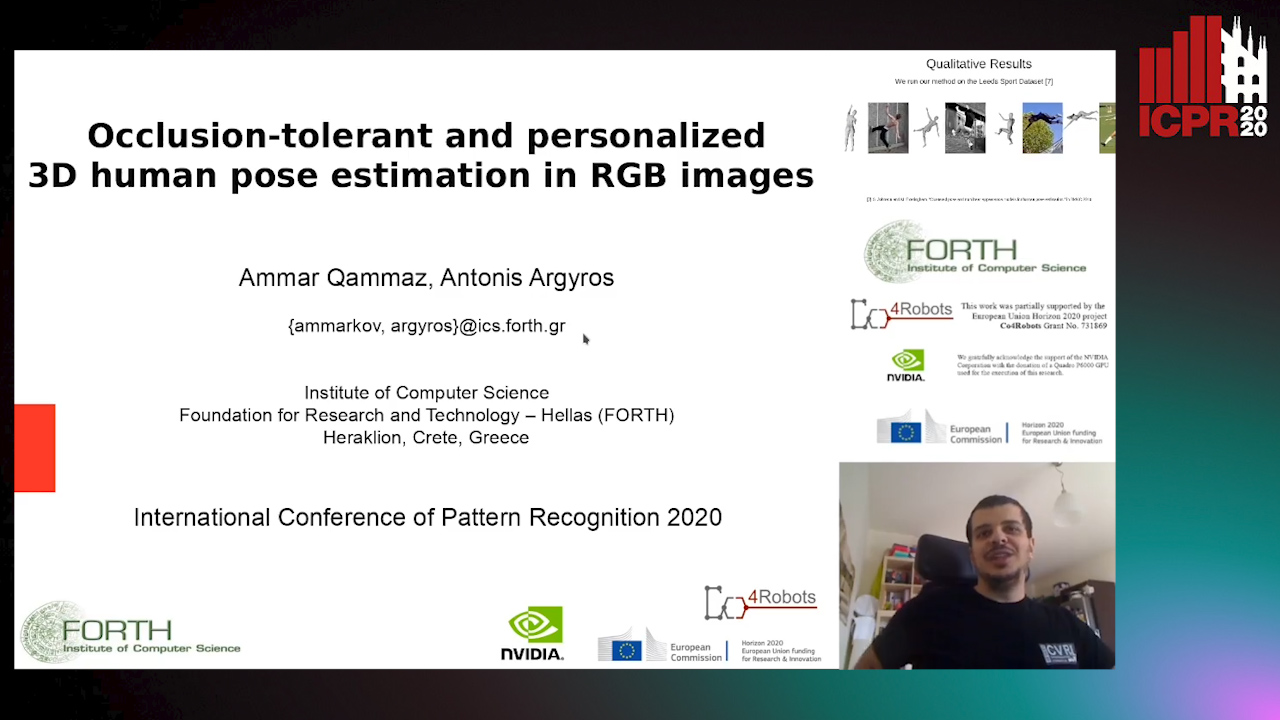
Auto-TLDR; Real-Time 3D Human Pose Estimation in BVH using Inverse Kinematics Solver and Neural Networks
Toward Building a Data-Driven System ForDetecting Mounting Actions of Black Beef Cattle
Yuriko Kawano, Susumu Saito, Nakano Teppei, Ikumi Kondo, Ryota Yamazaki, Hiromi Kusaka, Minoru Sakaguchi, Tetsuji Ogawa
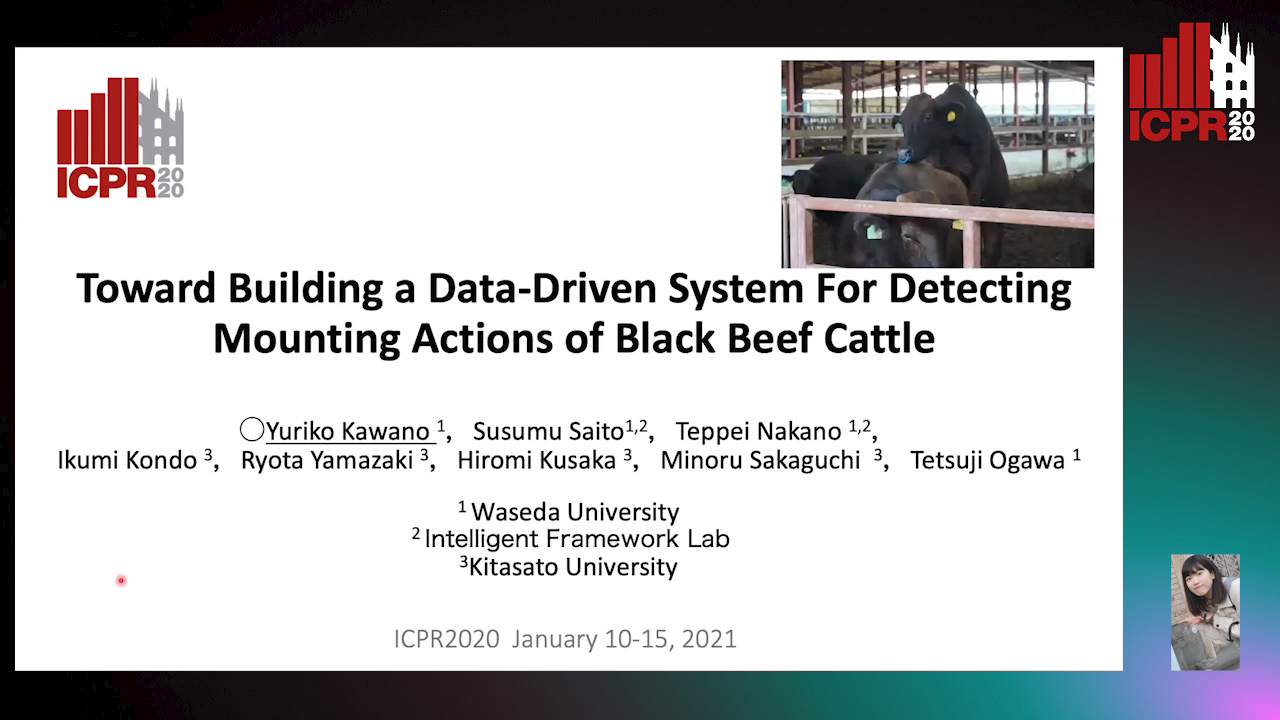
Auto-TLDR; Cattle Mounting Action Detection Using Crowdsourcing and Pattern Recognition
Unsupervised 3D Human Pose Estimation in Multi-view-multi-pose Video
Cheng Sun, Diego Thomas, Hiroshi Kawasaki
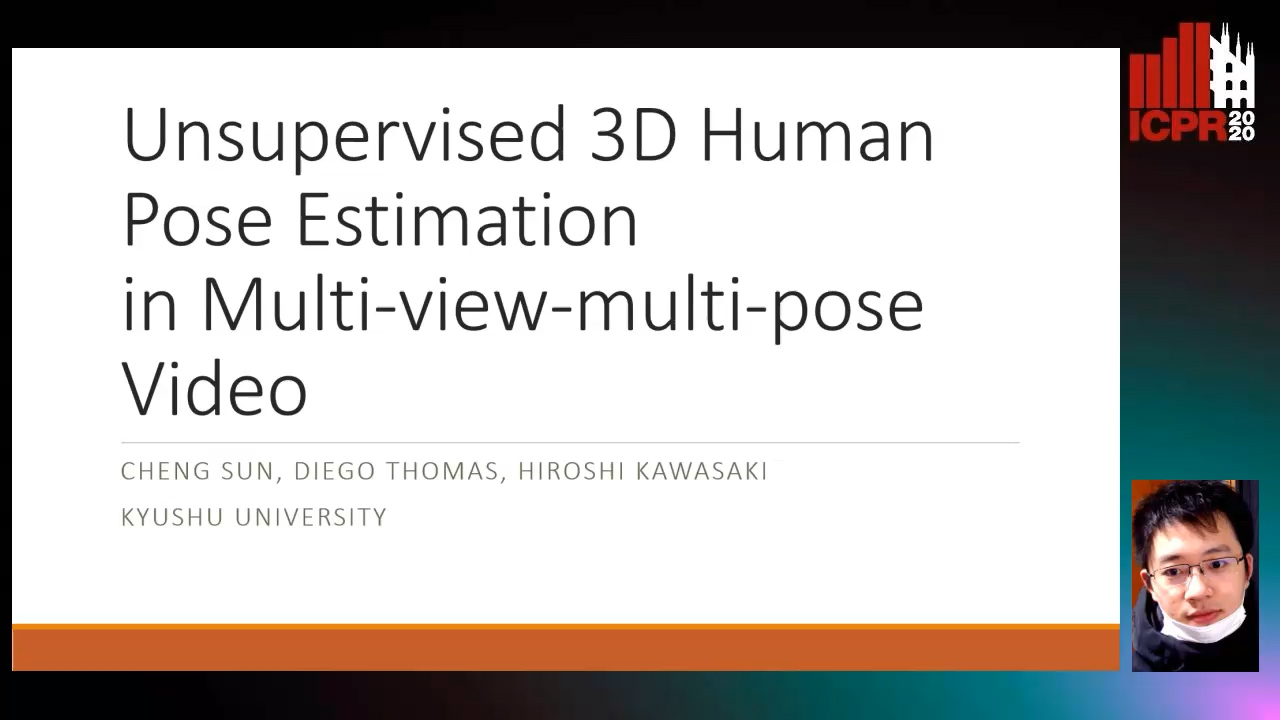
Auto-TLDR; Unsupervised 3D Human Pose Estimation from 2D Videos Using Generative Adversarial Network
Abstract Slides Poster Similar
Learning Group Activities from Skeletons without Individual Action Labels
Fabio Zappardino, Tiberio Uricchio, Lorenzo Seidenari, Alberto Del Bimbo

Auto-TLDR; Lean Pose Only for Group Activity Recognition
Temporal Extension Module for Skeleton-Based Action Recognition

Auto-TLDR; Extended Temporal Graph for Action Recognition with Kinetics-Skeleton
Abstract Slides Poster Similar
PEAN: 3D Hand Pose Estimation Adversarial Network
Linhui Sun, Yifan Zhang, Jing Lu, Jian Cheng, Hanqing Lu

Auto-TLDR; PEAN: 3D Hand Pose Estimation with Adversarial Learning Framework
Abstract Slides Poster Similar
Attention-Driven Body Pose Encoding for Human Activity Recognition
Bappaditya Debnath, Swagat Kumar, Marry O'Brien, Ardhendu Behera

Auto-TLDR; Attention-based Body Pose Encoding for Human Activity Recognition
Abstract Slides Poster Similar
Median-Shape Representation Learning for Category-Level Object Pose Estimation in Cluttered Environments
Hiroki Tatemichi, Yasutomo Kawanishi, Daisuke Deguchi, Ichiro Ide, Hiroshi Murase, Ayako Amma

Auto-TLDR; An Occlusion-Robust Pose Estimation Method from a Depth Image
Abstract Slides Poster Similar
JUMPS: Joints Upsampling Method for Pose Sequences
Lucas Mourot, Francois Le Clerc, Cédric Thébault, Pierre Hellier

Auto-TLDR; JUMPS: Increasing the Number of Joints in 2D Pose Estimation and Recovering Occluded or Missing Joints
Abstract Slides Poster Similar
Online Object Recognition Using CNN-Based Algorithm on High-Speed Camera Imaging
Shigeaki Namiki, Keiko Yokoyama, Shoji Yachida, Takashi Shibata, Hiroyoshi Miyano, Masatoshi Ishikawa

Auto-TLDR; Real-Time Object Recognition with High-Speed Camera Imaging with Population Data Clearing and Data Ensemble
Abstract Slides Poster Similar
On the Robustness of 3D Human Pose Estimation
Zerui Chen, Yan Huang, Liang Wang
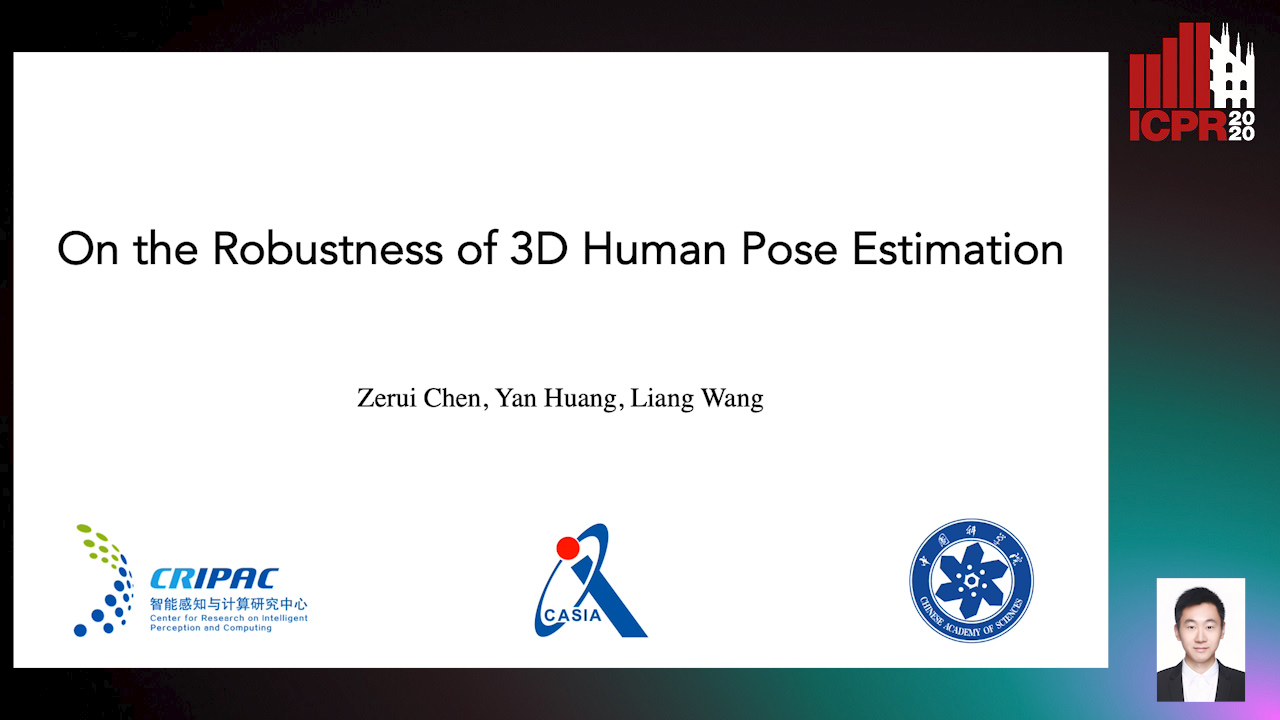
Auto-TLDR; Robustness of 3D Human Pose Estimation Methods to Adversarial Attacks
Efficient High-Resolution High-Level-Semantic Representation Learning for Human Pose Estimation

Auto-TLDR; Spatial enhanced separated temporal spatial convolutional neural network
Abstract Slides Poster Similar
Activity Recognition Using First-Person-View Cameras Based on Sparse Optical Flows
Peng-Yuan Kao, Yan-Jing Lei, Chia-Hao Chang, Chu-Song Chen, Ming-Sui Lee, Yi-Ping Hung

Auto-TLDR; 3D Convolutional Neural Network for Activity Recognition with FPV Videos
Abstract Slides Poster Similar
Modeling Long-Term Interactions to Enhance Action Recognition
Alejandro Cartas, Petia Radeva, Mariella Dimiccoli

Auto-TLDR; A Hierarchical Long Short-Term Memory Network for Action Recognition in Egocentric Videos
Abstract Slides Poster Similar
From Human Pose to On-Body Devices for Human-Activity Recognition
Fernando Moya Rueda, Gernot Fink

Auto-TLDR; Transfer Learning from Human Pose Estimation for Human Activity Recognition using Inertial Measurements from On-Body Devices
Abstract Slides Poster Similar
Tilting at Windmills: Data Augmentation for Deeppose Estimation Does Not Help with Occlusions
Rafal Pytel, Osman Semih Kayhan, Jan Van Gemert

Auto-TLDR; Targeted Keypoint and Body Part Occlusion Attacks for Human Pose Estimation
Abstract Slides Poster Similar
Channel-Wise Dense Connection Graph Convolutional Network for Skeleton-Based Action Recognition
Michael Lao Banteng, Zhiyong Wu

Auto-TLDR; Two-stream channel-wise dense connection GCN for human action recognition
Abstract Slides Poster Similar
PHNet: Parasite-Host Network for Video Crowd Counting
Shiqiao Meng, Jiajie Li, Weiwei Guo, Jinfeng Jiang, Lai Ye

Auto-TLDR; PHNet: A Parasite-Host Network for Video Crowd Counting
Abstract Slides Poster Similar
Late Fusion of Bayesian and Convolutional Models for Action Recognition
Camille Maurice, Francisco Madrigal, Frederic Lerasle

Auto-TLDR; Fusion of Deep Neural Network and Bayesian-based Approach for Temporal Action Recognition
Abstract Slides Poster Similar
Learning to Implicitly Represent 3D Human Body from Multi-Scale Features and Multi-View Images
Zhongguo Li, Magnus Oskarsson, Anders Heyden
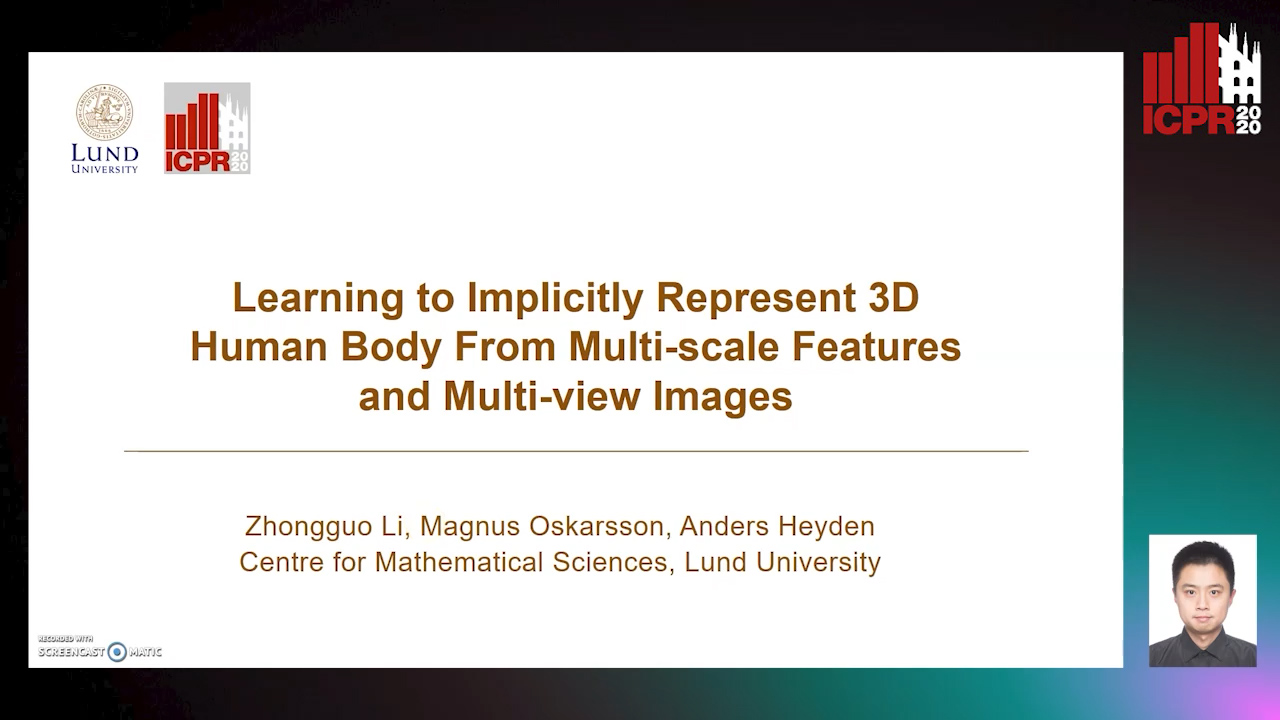
Auto-TLDR; Reconstruction of 3D human bodies from multi-view images using multi-stage end-to-end neural networks
Abstract Slides Poster Similar
Real-Time Monocular Depth Estimation with Extremely Light-Weight Neural Network
Mian Jhong Chiu, Wei-Chen Chiu, Hua-Tsung Chen, Jen-Hui Chuang

Auto-TLDR; Real-Time Light-Weight Depth Prediction for Obstacle Avoidance and Environment Sensing with Deep Learning-based CNN
Abstract Slides Poster Similar
RWF-2000: An Open Large Scale Video Database for Violence Detection
Ming Cheng, Kunjing Cai, Ming Li

Auto-TLDR; Flow Gated Network for Violence Detection in Surveillance Cameras
Abstract Slides Poster Similar